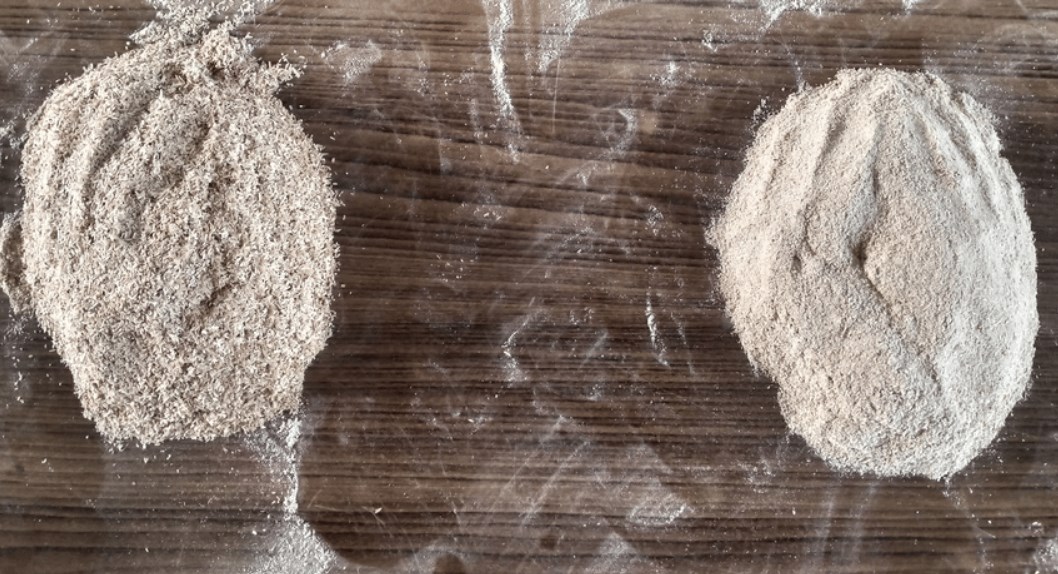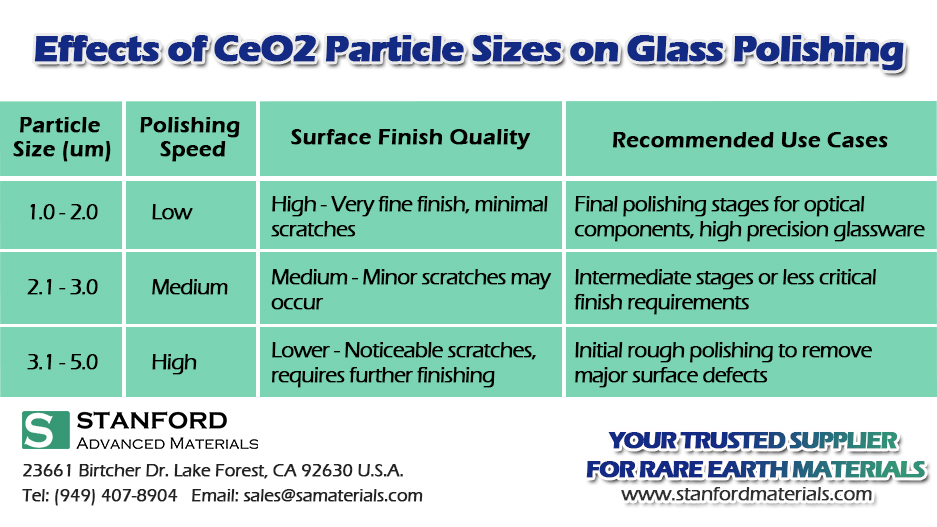In material finishing, the precise manipulation of surface characteristics is paramount, particularly in glass polishing, where the end quality can significantly affect optical performance and aesthetic appeal. Cerium oxide, a rare earth oxide, plays a critical role in this process due to its superior polishing capabilities. This article delves into how different particle sizes of cerium oxide influence the efficiency and effectiveness of glass polishing, a topic of great relevance for manufacturers and technicians in industries ranging from optics to consumer electronics.
QUICK LINKs:
Understanding the impact of particle size is essential for optimizing the polishing process to achieve the desired surface quality. The choice of particle size affects the rate at which material is removed from the glass surface and the type of finish it produces—ranging from rough, quick initial passes to fine, detailed finishing. By exploring these dynamics, this article aims to provide valuable insights into the strategic selection of cerium oxide particle sizes for various polishing needs, ensuring the best possible outcomes in both industrial and artisan applications.
Cerium oxide, due to its unique chemical and physical properties, has established itself as a pivotal material in the polishing industry. This oxide is primarily sourced from rare earth minerals and is known for its excellent abrasiveness and chemical stability, which make it particularly suitable for glass and silicon-based materials. Its primary function is to act as a polishing agent where it facilitates the removal of microscopic surface imperfections, enhancing the overall clarity and quality of the final product.
Cerium oxide powder
In the context of glass polishing, cerium oxide is favored over other compounds like aluminum oxide or silicon carbide because of its effectiveness in achieving a superior smooth finish with minimal scratching. The effectiveness comes from its ability to not only mechanically abrade the glass but also to interact with it chemically. This dual action helps in achieving a high-quality finish more efficiently than many other polishing agents can offer.
Moreover, the versatility of cerium oxide extends beyond just glass. It is also used in the polishing of optical components, electronic ceramics, and UV absorbers, among others. Its widespread use in different contexts underscores its adaptability and effectiveness across various materials and requirements. The selection of the appropriate particle size of cerium oxide is crucial in all these applications, as it directly influences the balance between polishing speed and the quality of the finish.
The particle size of cerium oxide polishing powder is a crucial factor that dictates both the polishing process's mechanics and the finished surface's quality. Particle size essentially refers to the diameter of the individual particles within the powder, commonly measured in micrometers (μm). This dimension significantly influences the powder's cutting force, the material removal rate, and the smoothness of the polished surface.
Smaller particles generally yield a finer finish, as they remove less material per pass and are less likely to cause surface defects such as scratches. This makes them ideal for applications requiring high precision, such as polishing optical lenses or finishing high-grade flat glass where clarity and smoothness are paramount. However, the trade-off is a slower polishing rate, requiring more time to achieve the desired finish.
Conversely, larger particles can expedite the material removal process, which is beneficial when substantial amounts of material need to be cleared, such as in the initial stages of polishing. These particles, due to their size, have a stronger cutting force and can quickly eliminate significant surface irregularities. However, their aggressive nature can also introduce scratches, which may not be acceptable for high-quality finishes.

Separation of the small particles from large particles. Ahmmad, Faysal & Sohel, Md. (2021). Development of an Effective Process to Produce Biomass Pellets Using Rice Husk. 10.13140/RG.2.2.13856.92165.
The choice of particle size is thus a balance between the speed of polishing and the quality of the finish achieved. It is influenced by several factors, including the type of glass, the specific requirements of the polishing process, and the desired final product quality. This balance is critical in industrial settings where both efficiency and product quality are key considerations.
In the world of glass polishing, the size of cerium oxide particles plays a pivotal role in determining both the efficiency of the polishing process and the quality of the final product. The recommended particle size for optimal glass polishing is generally between 1-5 micrometers (μm), which strikes a balance between efficient material removal and minimizing surface imperfections.
Table 1: Effects of Cerium Oxide Particle Sizes on Glass Polishing

Selecting the appropriate particle size of cerium oxide for glass polishing involves more than understanding its direct impact on efficiency and quality; it also requires consideration of several technical factors that influence the overall polishing process.
Table 2: Key Technical Considerations for Cerium Oxide Polishing
| Factor | Considerations | Best Practices |
|---|---|---|
| Material Hardness | Harder glass may need coarser particles; softer glass prefers finer. | Choose particle size based on glass hardness. |
| Compatibility | Effectiveness varies with glass composites and coatings. | Select particle size appropriate for glass type. |
| Suspension Properties | Finer particles enhance uniformity; coarser may settle and scratch. | Optimize particle size for uniform suspension. |
| Additives | Improves suspension stability; manage to avoid sedimentation. | Use appropriate additives for stable suspension. |
| Equipment | Type of equipment influences particle size efficiency. | Match particle size with polishing equipment. |
| Techniques | Different techniques benefit from specific particle sizes. | Adapt particle size to polishing technique. |
| Safety and Environment | Handling and disposal concerns, especially with finer particles. | Follow safety regulations; manage waste properly. |
| Cost Efficiency | Finer grades are costlier but may yield better finish. | Balance cost with material needs and yield. |
To illustrate the principles discussed, let's explore a few practical applications of cerium oxide in different glass polishing scenarios. These case studies demonstrate how varying particle sizes are strategically selected to meet specific polishing requirements and operational goals.
1. Optical Lenses:

2. Architectural Flat Glass:

3. Automotive Glass:

4. Art Glass and Decorative Pieces:

These case studies underscore the importance of selecting the right particle size of cerium oxide for specific glass polishing applications. Each scenario demonstrates how adjustments in particle size can directly influence both the efficiency of the polishing process and the quality of the final product. The choice of particle size thus becomes a strategic decision that integrates technical understanding with practical operational needs.
The selection of the appropriate particle size of cerium oxide for glass polishing is a critical decision that significantly impacts both the efficiency of the polishing process and the quality of the finished product. This article has explored how different particle sizes affect these outcomes and has highlighted the importance of matching the particle size to the specific requirements of the glass being polished.
Companies like Stanford Materials Corporation (SMC), which supply a wide range of cerium oxide polishing powders, play a crucial role in this sector. SMC offers various particle sizes of cerium oxide, accommodating the diverse needs of industries from high-tech to decorative glass crafting. They also provide customization options, allowing for even more precise alignment of the polishing agent with the specific polishing requirements of different projects.
Guidelines for Practitioners:
By following these guidelines, glass polishing operations can achieve a balance between speed and quality, ensuring that the final products meet the rigorous demands of their applications. Whether in high-tech industries, automotive manufacturing, or artistic glass crafting, the careful selection of cerium oxide particle size is a cornerstone of achieving excellence in glass polishing.
In conclusion, understanding and applying the principles of cerium oxide particle size in glass polishing not only enhances the efficiency of the process but also significantly improves the quality of the glass surfaces, contributing to better performance and higher satisfaction in various applications.
Eric Loewen
Eric Loewen graduated from the University of Illinois studying applied chemistry. His educational background gives him a broad base from which to approach many topics. He has been working with topics about advanced materials for over 5 years at Stanford Materials Corporation (SMC). His main purpose in writing these articles is to provide a free, yet quality resource for readers. He welcomes feedback on typos, errors, or differences in opinion that readers come across.